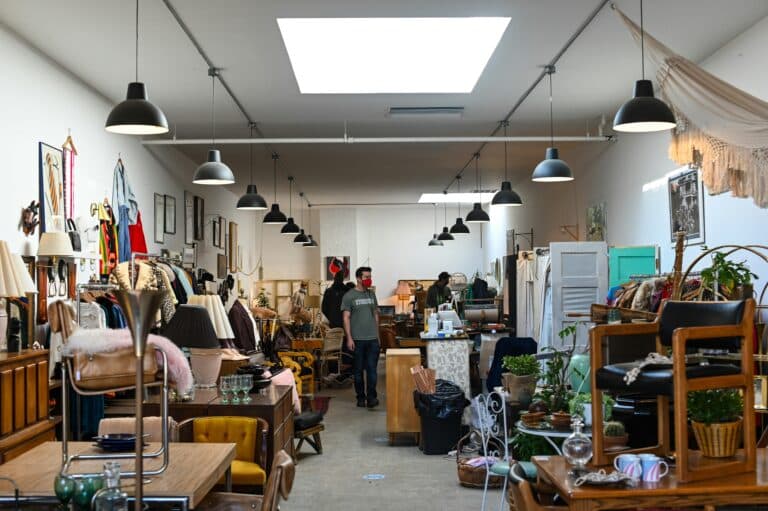🕵️♂️🏷️ But beyond these obvious charms, the world of pre-loved items can also be a powerful tool for productivity. Yes, you heard right! Productivity and second-hand shopping might seem like strange bedfellows, but with the right approach, one can significantly boost the other. How so? We’re about to embark on a deep-dive into this intriguing territory, uncovering how you can harness the power of second-hand shopping guides to enhance efficiency and save money.
For starters, consider this – in the vast landscape of second-hand shopping, you’re not just a consumer; you’re a strategic decision-maker, a savvy deal-hunter. You have the power to make or break your budget, to elevate your efficiency, and to make choices that align with your personal and professional goals. The stakes are higher than they might appear at first glance, making it crucial to arm yourself with knowledge and strategy. 💼🎯
Think of a second-hand shopping guide as a map to treasure. It will steer you through the twists and turns of this terrain, from online platforms to local thrift stores, and help you uncover the real gems – whether it’s office equipment, software, or other productivity tools. With a keen eye and the right guidance, you can strike gold and significantly cut costs, without compromising on quality or functionality. 🗺️💎
The intriguing intertwining of second-hand shopping and productivity is a topic ripe for exploration, and that’s exactly what we’re going to do in this comprehensive article. We will delve into various aspects of second-hand shopping, discuss the most reliable guides, and explore how the right strategies can help you optimize productivity while keeping your budget in check. 💡📚
Get ready to delve into how to strategically navigate the world of second-hand purchases, how to choose the right platforms and find reliable sources, and how to ensure the items you buy genuinely contribute to your productivity. We’ll also tackle the topic of sustainability, showing how your smart shopping choices can make a difference not just to your wallet, but to the planet too. 🌎💰
By the end of this journey, you’ll have an arsenal of strategies and insights to help you leverage the world of second-hand shopping to your advantage. Whether you’re an entrepreneur looking to maximize efficiency in your start-up, a freelancer wanting to make the most of a limited budget, or a company looking to reduce costs and boost productivity, this guide is for you. 🚀💼
So buckle up and prepare for an insightful journey into the world of second-hand shopping, productivity, and savvy saving. Who knew that the humble thrift shop or online resale platform could hold the key to such powerful productivity gains? It’s time to unlock that potential, and this guide will be your key. 🔑🛍️
Get ready to transform your perceptions, broaden your horizons, and take control of your productivity in a way you might never have thought possible. Let’s dive in! 🌊💪
The Phenomenon of Second-Hand Shopping
In recent years, there’s been a resurgence of interest in second-hand shopping. This isn’t just a passing trend, but a global movement that’s transforming the way we think about consumption. From clothing to electronics, used goods are finding new life in the hands of savvy shoppers, and it’s all thanks to the power of second-hand shopping guides. 🔄🛍️
But why is second-hand shopping so effective, and how can it boost productivity and save money? To answer these questions, we need to delve deeper into the phenomenon of second-hand shopping and understand the role of shopping guides in this context. Let’s take a look at how second-hand shopping works, and why it’s become such an essential part of modern consumer culture.

Second-hand shopping, also known as thrift shopping or op shopping, involves buying used goods instead of new ones. These goods can range from clothes and accessories to furniture, appliances, and even vehicles. The main appeal of second-hand shopping is its cost-effectiveness: used goods are typically much cheaper than new ones, allowing shoppers to save money while still getting what they need. But the benefits of second-hand shopping go beyond just saving money. It’s also a more sustainable form of consumption, as it reduces waste and conserves resources.
The Role of Shopping Guides in Second-Hand Shopping
So, where do second-hand shopping guides come in? Simply put, these guides provide valuable information and tips for navigating the world of second-hand shopping. They cover everything from where to find the best deals to how to determine the quality and value of used goods. With a good second-hand shopping guide, you can maximize your productivity and efficiency, making the most of your shopping trips and getting the best bang for your buck.
A typical second-hand shopping guide might include sections on different types of second-hand goods (clothes, electronics, furniture, etc.), tips on bargaining and negotiating prices, advice on inspecting used goods for quality and condition, and much more. Some guides even include reviews and recommendations for specific second-hand shops or online platforms, making it easier for you to find reliable sources for used goods.
But the usefulness of second-hand shopping guides isn’t just limited to the practical tips and advice they offer. These guides also foster a sense of community among second-hand shoppers, encouraging them to share their experiences and insights with each other. This communal aspect of second-hand shopping is what makes it so unique and rewarding, adding a social dimension to the shopping experience that’s often lacking in traditional retail.
Maximizing Productivity with Second-Hand Shopping Guides
Now that we’ve established what second-hand shopping and shopping guides are, let’s move on to the main topic of this article: how to maximize productivity with second-hand shopping guides. This might seem like a tall order, but with the right strategies and tools, it’s more than achievable.
The key to boosting productivity with second-hand shopping guides lies in how you use them. Instead of simply following the advice in these guides, you should use them as a starting point for your own shopping strategies. This means taking the information in the guides and adapting it to your specific needs and circumstances.
For example, if a guide recommends visiting a particular second-hand shop, don’t just take this advice at face value. Instead, research the shop, find out what types of goods it sells and what its prices are like, and then decide whether it’s worth your time and effort. Similarly, if a guide offers tips on bargaining, consider your own negotiation skills and comfort level before applying these tips.
Practical Tips for Using Second-Hand Shopping Guides
To help you get started, here are some practical tips for using second-hand shopping guides:
- Do your homework: Before you start shopping, spend some time reading and understanding the guide. Make sure you know what to look for and what to avoid in second-hand goods.
- Be flexible: Don’t stick rigidly to the advice in the guide. Be willing to adapt and experiment, and don’t be afraid to make mistakes. Remember, the goal is to learn and improve, not to be perfect.
- Keep an open mind: Second-hand shopping is all about discovery and surprise. Don’t limit yourself to specific brands or products, and be open to trying new things.
- Plan your shopping trips: Use the guide to plan your shopping trips in advance. Decide where you’re going to shop, what you’re looking for, and how much you’re willing to spend.
- Network with other shoppers: Use the guide to connect with other second-hand shoppers. Share your experiences and learn from theirs.
By following these tips, you can make the most of second-hand shopping guides and boost your productivity and efficiency. And as an added bonus, you’ll also save money in the process!
Recommended YouTube Videos on Second-Hand Shopping
If you’re interested in learning more about second-hand shopping and how to make the most of it, I highly recommend checking out the following YouTube videos:
1. “Thrifting 101: How to Find the Best Clothes” by JENerationDIY. This video provides a comprehensive guide to thrift shopping for clothes, with tips on where to go, what to look for, and how to style your finds.
2. “How to Shop Second Hand!” by Sarah Hawkinson. In this video, Sarah shares her tips and tricks for successful second-hand shopping, including how to find the best deals and how to inspect used goods for quality.
3. “10 THRIFT SHOPPING SECRETS: How to find Designer & Vintage” by itsHadrian. This video takes you on a thrift shopping adventure, showcasing the process of finding and buying designer and vintage goods at thrift shops.
Boost Your Efficiency and Save Money with Second-Hand Shopping
As we’ve seen, second-hand shopping is not only a great way to save money, but also a powerful tool for boosting productivity and efficiency. With the help of second-hand shopping guides, you can navigate the world of used goods with confidence and ease, finding the best deals and making the most of your shopping trips.
So why not give second-hand shopping a try? With a bit of patience and persistence, you’ll soon discover the joys of thrift shopping and the benefits it can bring to your life. Happy shopping! 💼🎉
Conclusion
As we conclude this extensive yet insightful exploration into the depths of software engineering and information technology, it is evident that the fields are laden with complexities that demand deep understanding. From the intricate aspects of coding, system development and system analysis, to the more nuanced elements of user experience and interface design, our foray has been a holistic immersion into the world of technology.
Our journey began by dissecting the basic building blocks of software engineering, where we learnt that it is essentially an engineering branch associated with the development of software product using well-defined scientific principles, methods and procedures. The outcome of software engineering is an efficient and reliable software product [1] 🧩.
The discourse evolved to understanding the significance of coding, the writing of instructions for computers to implement a particular task. It’s through coding that we interact with machines and give them tasks to perform. Coding languages such as Python, Java, and C++ have been instrumental in facilitating this communication [2] 👨💻.
System development and system analysis were another focal point of our discussion. We discovered that system development is the process of creating or altering systems, and the methodologies used in doing so. System analysis, on the other hand, is the interpretation of business rules and requirements for technical systems. Together, they form a fundamental part of software engineering [3] 🖥️.
To give a human touch to our technology, we dived into the realm of user experience and interface design. These ensure that the digital interfaces we interact with daily are intuitive and user-friendly. These aspects combine aesthetics with functionality to deliver a seamless experience to the end-users [4] 🎨.
In retrospect, we’ve embarked on a journey that has unfolded the mysteries of software engineering and information technology in a comprehensive yet digestible format. The complexities we’ve uncovered serve as the backbone of the digital revolution we’re part of today. It’s the unyielding spirit of curiosity and the relentless pursuit of knowledge that propels this field, and it’s this spirit that will continue to push the boundaries of what is possible in the digital realm.
As you venture forth and continue to explore this captivating world, remember that the knowledge acquired is a powerful tool. Share it, discuss it, and apply it. We invite your thoughts and comments on this insightful exploration, and encourage you to share this wealth of information with your peers, thus contributing to the ever-evolving discourse on technology 💡.
With all the knowledge we’ve accumulated, the journey doesn’t end here. It is the commencement of a continuous learning process. After all, technology is ever-evolving, just like our thirst for knowledge should be 🚀.
Thank you for being part of this enlightening journey. Until next time, keep exploring, keep learning, and above all, keep sharing. After all, knowledge shared is knowledge multiplied.
Happy learning! 🎓
References:
1. Software Engineering Overview. (n.d.). Tutorials Point. https://www.tutorialspoint.com/software_engineering/software_engineering_overview.htm
2. What is Coding Used for? (n.d.). FreeCodeCamp. https://www.freecodecamp.org/news/what-is-coding-used-for-basics-for-beginners/
3. Systems Development Life Cycle (SDLC). (n.d.). Investopedia. https://www.investopedia.com/terms/s/systems-development-life-cycle.asp
4. The Difference Between UX and UI Design – A Layman’s Guide. (n.d.). CareerFoundry. https://careerfoundry.com/en/blog/ux-design/the-difference-between-ux-and-ui-design-a-laymans-guide/



